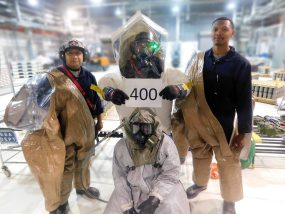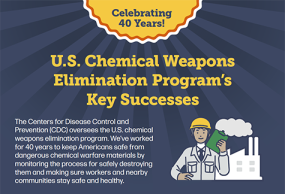CDC’s Role in Protecting Public Health in During Chemical Demilitarization
The Centers for Disease Control and Prevention (CDC) provides recommendations to the U. S. Department of Defense (DoD) chemical demilitarization program to ensure the safe destruction of chemical warfare material for protection of public health. CDC makes recommendations regarding both recovered chemical weapons and other chemical agent material and the completed destruction of the U.S. stockpile of chemical weapons.
In 1970, Congress passed PL 91-121/441 (50 USC 1512). This law directed what is now the Department of Health and Human Services (HHS) and the Office of the Surgeon General (OSG) to review DoD plans to transport, test, or dispose of lethal chemical agents, and to recommend actions to protect the public’s health and safety during such activities.

Stockpiled Chemical Weapons
Read our success stories.
CDC helps ensure safe destruction of chemical warfare material and protect public health and safety by
- Reviewing DoD’s plans for disposing of chemical warfare agents. This review includes staffing and design specifications for system safeguards and performance. CDC also recommends precautionary measures to avoid potential hazards and protect public health and safety.
- Observing required readiness demonstrations before any chemical warfare agent destruction operation begins.
- Conducting periodic on-site inspections during long-term destruction operations.
- Reviewing biweekly reports of air monitoring data for quality assurance at operating and closing stockpile destruction facilities.
- Recommending chemical warfare agent airborne exposure limits to protect the public and the workers who dispose of those chemical warfare agents.
- Reviewing plans for closing chemical disposal facilities, including decontaminating, dismantling, and demolishing the chemical warfare agent disposal equipment and buildings.
- Assessing the public health effects of any unintended disposal-related exposure to a chemical warfare agent.

Workers celebrating 400th
Demilitarization Protective Ensemble EntryCollaborating with state and local authorities to respond to public health concerns about chemical warfare agent disposal.
- Reviewing plans for transporting any chemical warfare agents.
- Evaluating the medical program at each chemical agent disposal facility. Ensure the medical clinic, staff, procedures, and plans can meet occupational medicine challenges, including emergencies related to chemical agent disposal.
- Participating in the Chemical Stockpile Emergency Preparedness Program.
CDC’s Role in the Offsite Shipment of Secondary Waste
- The U. S. Army disposes of some secondary wastes offsite at hazardous waste treatment and disposal facilities. CDC continues to monitor public health aspects of treating secondary waste by reviewing documentation provided by the U. S. Army and its contractors. Documents typically provided to CDC include information on characterization of the waste, specific plans for health and safety, and the risk associated with transportation. Any offsite shipment approach should clearly demonstrate that any human health and safety risks are fully considered and satisfactorily addressed.
- More information about secondary chemical agent waste is available in the National Research Council’s (NRC) Review of Chemical Agent Secondary Waste Disposal and Regulatory Requirements, 2007. The NRC is the operating arm of the United States National Academies of Sciences, Engineering, and Medicine. More information about the NRC can be found at National Academies webpage.
Additional Resources
- Publications and other documents (cdc.gov)
- Prediction of acute mammalian toxicity using QSAR methods: a case study of sulfur mustard and its breakdown products (cdc.gov)
- Notes from the Field: Exposures to Discarded Sulfur Mustard Munitions — Mid-Atlantic and New England States 2004–2012 (cdc.gov)
- Emergency Room Procedures in Chemical Hazard Emergencies: A Job Aid (cdc.gov) (Archived content)
